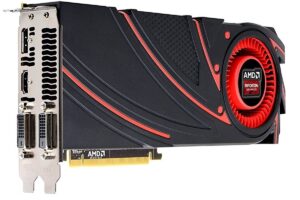AMD Radeon R9 M290X is a GCN architecture notebook card built on a 28 nm manufacturing process. It primarily targets the gamers. Indeed, it comes with 4 GB of GDDR5 memory clocked at 1.2 GHz. Along with a 256 Bit memory interface this forms a bandwidth of 153.6 GB/s. The power consumption ranges at 100 Watt. In fact, the graphics card AMD Radeon R9 M290X functions with a minimal clock speed of 850 MHz. It offers an acceleration option and is able to run up to 900 MHz.
Technical specifications

The Radeon R9 M290X is a mobile graphics chip from AMD. The release date of this mobile graphics chip traces back to 9th January, 2014. Formulated on the 28 nm process, and based upon the Neptune graphics processor, the chip supports DirectX 12 in its Neptune XT variant. However, even though it holds up DirectX 12, the feature level is only 11_1. Thus, this can prove to be problematic with newer DirectX 12 titles.
The Neptune graphics processor is a medium size chip with a die area of 212 millimeter square and 2,800 million transistors. Indeed, it offers 1280 shading units, 80 texture mapping units, and 32 ROPs. AMD has combined 4 GB GDDR5 memory with the Radeon R9 M290X. A 256-bit memory interface connects them. The GPU is functioning at a frequency of 850 MHz. You can easily boost it up to 900 MHz. Memory is operating at 1200 MHz (4.8 Gbps effective).
Being a mxm module card, the AMD Radeon R9 M290X does not need any extra power connector. Its power draw is 100 W maximum. In fact, the AMD Radeon R9 M290X has no display connectivity. This is because AMD did not devise it to have monitors connected to it. Rather, you can use it in laptops or notebooks. Let us tell you that AMD Radeon R9 M290X will deploy the output of the host mobile device. It links to the rest of the system using a PCI-Express 3.0 x16 interface.
Detailed review

The AMD Radeon R9 M290X is a 28 nm DirectX 12 graphics card. The architecture behind it is GCN (Graphics Core Next). If we talk of comparative analysis, then we must mention that its performance and features are similar to HD 8970M. Both of them offer the same core and come with the same clock rates. You can locate the roots of the design of the Radeon R9 M290 series in the Pitcairn chip. You can find the Pitcairn chip on the desktop Radeon HD 7870.
In particular, the M290X is identical to its desktop Radeon HD 7870 counterpart with 1280 1D shader cores and 80 texture units. However, the AMD Radeon R9 M290X comes with a core clock of only 900 MHz (boost) in contrast to the 1000 MHz clock of the HD 7870. If we compare M290X with HD 7970M, then we must let you know that M290X shares the same base clock rate. However, it does so with a 50 MHz higher Turbo clock for a 6% increase in raw SP calculations. Therefore, the general performance of the M290X stands somewhere between the 7850 and 7870 desktop Radeon cards.
Performance
The M290X is just a relaunch of the HD 8970M with very similar performance. Therefore, almost all challenging games of 2013 will run smoothly on very high details and 1080p resolution. It is completely capable of driving high-end games.

Features
The AMD Radeon R9 M290X comes with the new UVD3 video decoder. The M290 series also holds up automatic graphics switching between the integrated GPU and discrete GPU. Termed as Enduro, the technology supersedes AMD’s Dynamic Switchable Graphics and is identical to Nvidia’s Optimus. What is even more interesting is the fact that the M290X can immediately support up to 6 monitors using Eyefinity technology if you disable Enduro. When you turn off the display, you can use ZeroCore for reducing power consumption.
Also read: Here Is Everything You Need To Know About Asus tuf fx705
